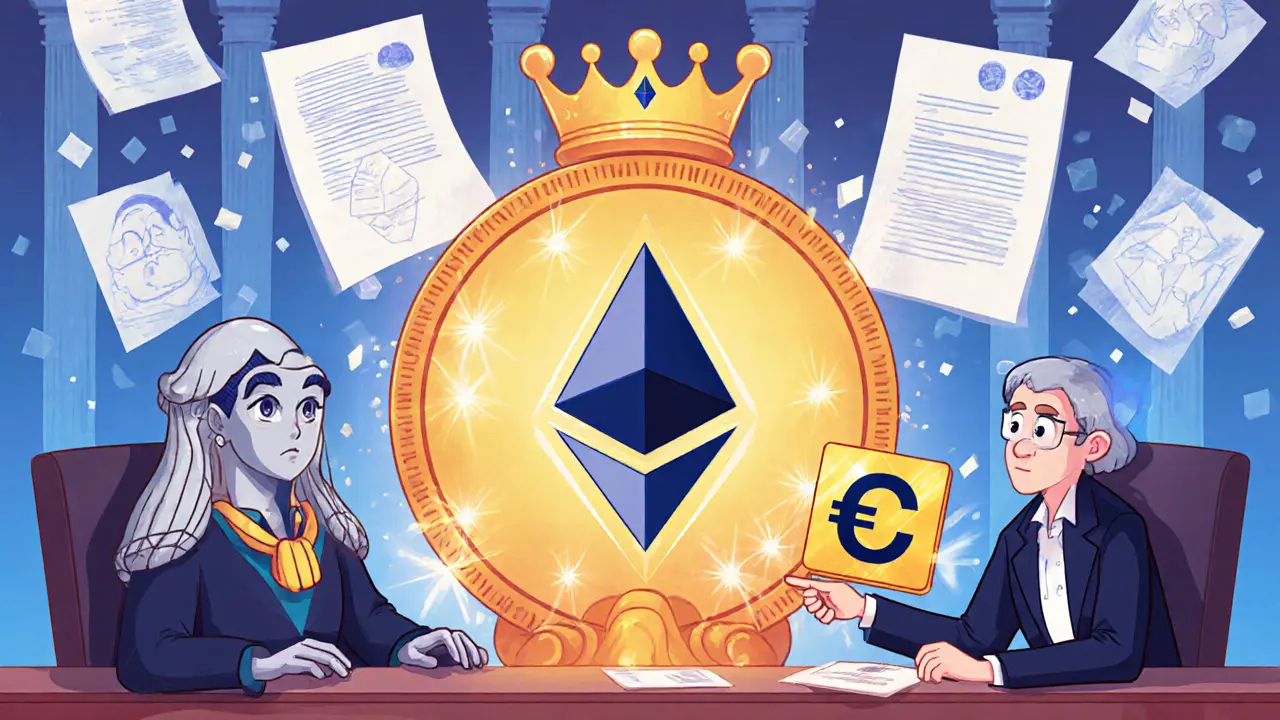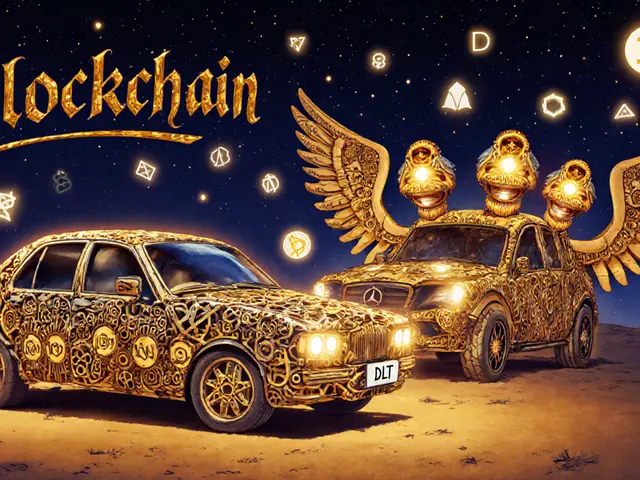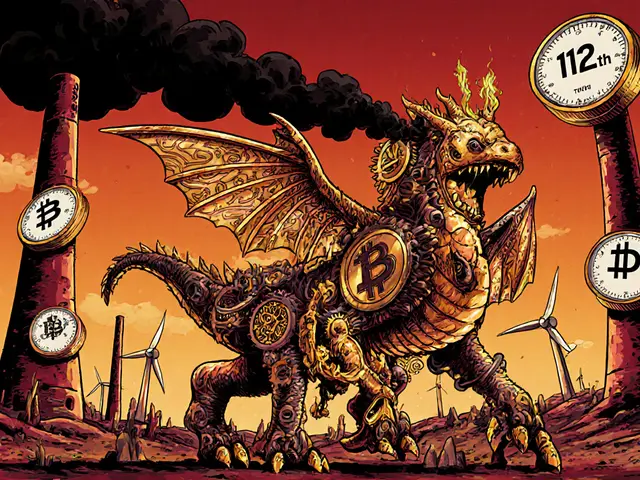When you buy an NFT of a digital artwork, you might think you own the art itself. You don’t. You own a token on the blockchain - a digital certificate of ownership for that specific file. The actual image, music, or video? That’s still controlled by the artist or the project team. This confusion is why so many people end up disappointed - or even sued - after buying an NFT.
What You Actually Get With an NFT
An NFT is not the artwork. It’s a unique digital key that points to the artwork, stored on a blockchain like Ethereum. Think of it like buying a numbered print of a painting. You own that specific print, but you don’t own the original painting or the right to reproduce it. The same logic applies here.
Most NFT projects make this clear in their terms of service. For example, the official terms from CryptoPunks (before March 2022) stated: “You acquire all right, title, and interest in and to the NFT, but you do not gain any right, title, or interest in or to any of the artwork.” Even after they later granted commercial rights, they still made it explicit: your rights come from their license, not from owning the token.
There’s no automatic transfer of copyright. Copyright law doesn’t care about blockchain records. It cares about who created the work and whether they’ve legally given you permission to use it. That’s why someone who paid $2.9 million for Jack Dorsey’s first tweet NFT couldn’t print it on T-shirts or sell it as a poster - they owned the token, not the tweet’s rights.
The Three Types of NFT Art Rights
Not all NFTs are the same when it comes to what you can do with the art. There are basically three categories of rights you might get:
- No rights / Silence - Many projects don’t say anything about usage. In these cases, you’re lucky if you can even display the image on your profile. Printing it, selling merchandise, or using it in a video could be copyright infringement. You own the token, but the artist keeps all rights.
- Personal use only - Some projects give you permission to display the art on your website, social media, or in your digital wallet. But you can’t use it to make money. This is common with smaller or emerging artists who want exposure but aren’t ready to give up control.
- Commercial rights - A few big projects, like Bored Ape Yacht Club (BAYC) and CryptoPunks (after March 2022), give you full rights to use the image commercially. You can make merch, movies, games, or even license it to others. This is rare - only about 20% of NFT collections offer this - but it’s why these NFTs trade for hundreds of thousands of dollars.
A DappRadar report from Q2 2023 found that NFT collections with clear commercial rights had floor prices 37% higher than those without. Buyers are paying extra for the freedom to monetize. If you’re buying an NFT to build a brand, run a business, or create derivative content, you need to know which category you’re in.
Why This Confusion Exists
Most people think buying an NFT is like buying a physical painting. You hang it on your wall, you own it, you can do what you want. But digital files are different. You can copy a JPEG a million times. The NFT doesn’t stop that. It just proves you own the original version - like a signed certificate.
Marketplaces like OpenSea don’t explain this clearly. A CoinGecko survey in 2023 found that only 32% of NFT marketplaces show IP rights information at the point of sale. Most buyers scroll past the terms, click “Buy,” and assume they own the art. That’s a dangerous assumption.
Reddit threads are full of stories from people who got in trouble. One buyer printed Bored Ape images on shirts and sold them - only to get a cease-and-desist letter from Yuga Labs, even though BAYC allows commercial use. Why? Because they bought a different NFT collection that didn’t. Another person tried to trademark a CryptoPunk image - and got shut down by Yuga Labs, who still held the copyright.
According to a June 2023 Trustpilot analysis, 42% of negative reviews for NFT marketplaces cited unclear IP rights as the main complaint. The problem isn’t the tech - it’s the lack of transparency.

How to Know What Rights You Have
You can’t guess. You have to check. Here’s how:
- Go to the project’s official website - Not the marketplace. Look for a “License,” “Terms,” or “IP Rights” section. If it’s not there, assume you have no rights.
- Read the smart contract - If you’re comfortable with code, check the contract on Etherscan. Look for keywords like “license,” “grant,” “commercial,” or “sublicense.” If it says “all rights reserved,” you have nothing.
- Look for the license type - Some projects use standard licenses like CC0 (public domain), MIT, or custom ones like the “Can’t Be Evil” license. CC0 means you can do anything - even sell the art as your own. But only if the project says so.
- Ask the team - If the terms are vague, DM the project’s official Discord or Twitter. Get a written answer. If they can’t or won’t answer, walk away.
For high-value purchases - think $10,000 or more - hire a lawyer who understands digital assets. It’s not expensive, and it could save you from a lawsuit.
What Artists Should Know
If you’re creating NFT art, your rights matter too. You own the copyright unless you give it away. Many artists mint NFTs of work they didn’t create - fan art, memes, or AI-generated images. That’s risky. Even if you’re the one minting, if you didn’t create the image, you don’t own the copyright. You could be sued.
The U.S. Copyright Office says AI-generated art without human creative input isn’t copyrightable. So if you used Midjourney or DALL·E and didn’t heavily edit the output, you might not even own the rights to your own NFT. That’s a legal gray zone - and it’s growing. In Q2 2023, 18% of all NFT art sales were AI-generated.
Be clear in your terms. Don’t assume buyers know the difference. If you want to keep control, say so. If you want to let people make merch, say that too. Transparency builds trust - and value.

The Bigger Picture
The NFT market is still young. In 2021, total sales hit $24.7 billion. By 2022, that dropped to $8.8 billion. But the legal framework is catching up. Deloitte found that 73% of big brands now clearly define IP rights in their NFTs - up from 41% in 2021. That’s progress.
But independent artists? Only 28% include clear licensing terms. That’s a problem. Without clear rules, the market stays chaotic. Courts are starting to step in. The first major U.S. case, McFarland v. Doe, is now in preliminary stages. It could set a precedent for how copyright applies to NFTs.
Meanwhile, the European Union’s Digital Markets Act and WIPO’s NFT working group are trying to create global standards. But for now, it’s a patchwork. What’s legal in the U.S. might not be in Germany or Japan.
Bottom Line
Owning an NFT doesn’t mean you own the art. It means you own a token that proves you own a specific version of it. Everything else - copying, selling, making merch, using it in a movie - depends on the license the project gives you.
Never assume. Always check. Read the fine print. If it’s not written down, it doesn’t exist. And if you’re spending serious money on an NFT, treat it like a legal contract - because it is.
The future of NFT art isn’t just about rarity or hype. It’s about clear, enforceable rights. The projects that get this right will thrive. The ones that don’t? They’ll be forgotten - or sued.











13 Comments
This is the most important thing people need to hear before buying an NFT.
Of course you don’t own the art. You own a JPEG with a fancy hash. Congrats.
Bro i just bought a Bored Ape thinking i could make shirts with it and now i’m scared to even post it on instagram 😭
Thanks for this post. I didn’t realize how many people are getting sued over this. I’m gonna go read the terms now.
People are still falling for this? After the whole FTX collapse and all the rug pulls? You think a blockchain token gives you copyright? That’s not tech, that’s delusion wrapped in a gas fee.
Hey, if you’re new to NFTs and just want to support artists, here’s a tip: look for collections that say ‘CC0’ or ‘commercial rights granted’ in the description. Those are the ones where you’re actually safe to use the art. And if it’s not clear? DM the team. Most are happy to clarify. You’re not being annoying - you’re being smart.
The real tragedy isn’t that people think they own the art - it’s that artists themselves don’t understand how to protect their own work. I’ve seen so many creators mint NFTs of fan art, AI-generated images, or even stock photos and then get shocked when they get sued. You can’t copyright someone else’s creativity just because you put it on the blockchain. The tech doesn’t rewrite copyright law - it just makes it easier to get sued. If you’re an artist, stop treating NFTs like a magic wand. They’re a tool. Use them responsibly.
Wow so you mean I didn’t buy the Mona Lisa? I thought I was rich. My bad.
There is no such thing as ‘owning’ a digital file. Ownership implies control. You control nothing. You control a pointer to a URL that could vanish tomorrow. The blockchain doesn’t store the image. It stores metadata. The image is hosted on IPFS or AWS. If the server goes down, your ‘ownership’ is a dead link. This isn’t ownership. It’s digital wishful thinking.
Thank you for this thorough breakdown. As someone who works in digital rights law, I can confirm: copyright transfer requires explicit, written consent - not a blockchain transaction. The confusion stems from conflating provenance with permission. Provenance is about origin; permission is about usage. They are legally distinct. Marketplaces have a duty to disclose licensing terms at the point of sale - failing to do so is not just unethical, it’s potentially deceptive under FTC guidelines. Buyers must be informed, not misled.
Let me guess - you’re one of those people who thinks NFTs are ‘just art’ and not a weaponized capitalist fantasy. You think reading the terms is ‘responsible.’ Newsflash: the terms are written by lawyers who want you to think you have rights while they keep all the real power. BAYC lets you make merch? Great. Until they change the terms. Until they revoke your license. Until they sue you for ‘brand dilution’ because you used the ape in a political ad. This isn’t ownership. It’s a subscription. And you’re the customer.
so i bought this nft of a cat wearing a hat and i thought i could make it into a hoodie and sell it on etsy but then i realized i have no idea what the license says and now i’m just sitting here staring at my screen wondering if i’m gonna get a letter from a lawyer 😅
also the artist’s discord is dead so idk what to do
maybe i should just print it for my wall and pretend it’s fine??
anyone else do this? i feel so dumb
This is a critical conversation that needs to be had. The NFT space has moved too fast, and legal literacy has lagged behind. But there’s hope. More projects are starting to adopt clear licensing frameworks - and buyers are beginning to demand them. The market will evolve. The ones who prioritize transparency will build lasting value. The ones who exploit confusion? They’ll fade into the noise. Stay informed. Stay cautious. And don’t let hype override common sense.
So… if I own the token, but not the art… what exactly am I paying for? Just the bragging rights?